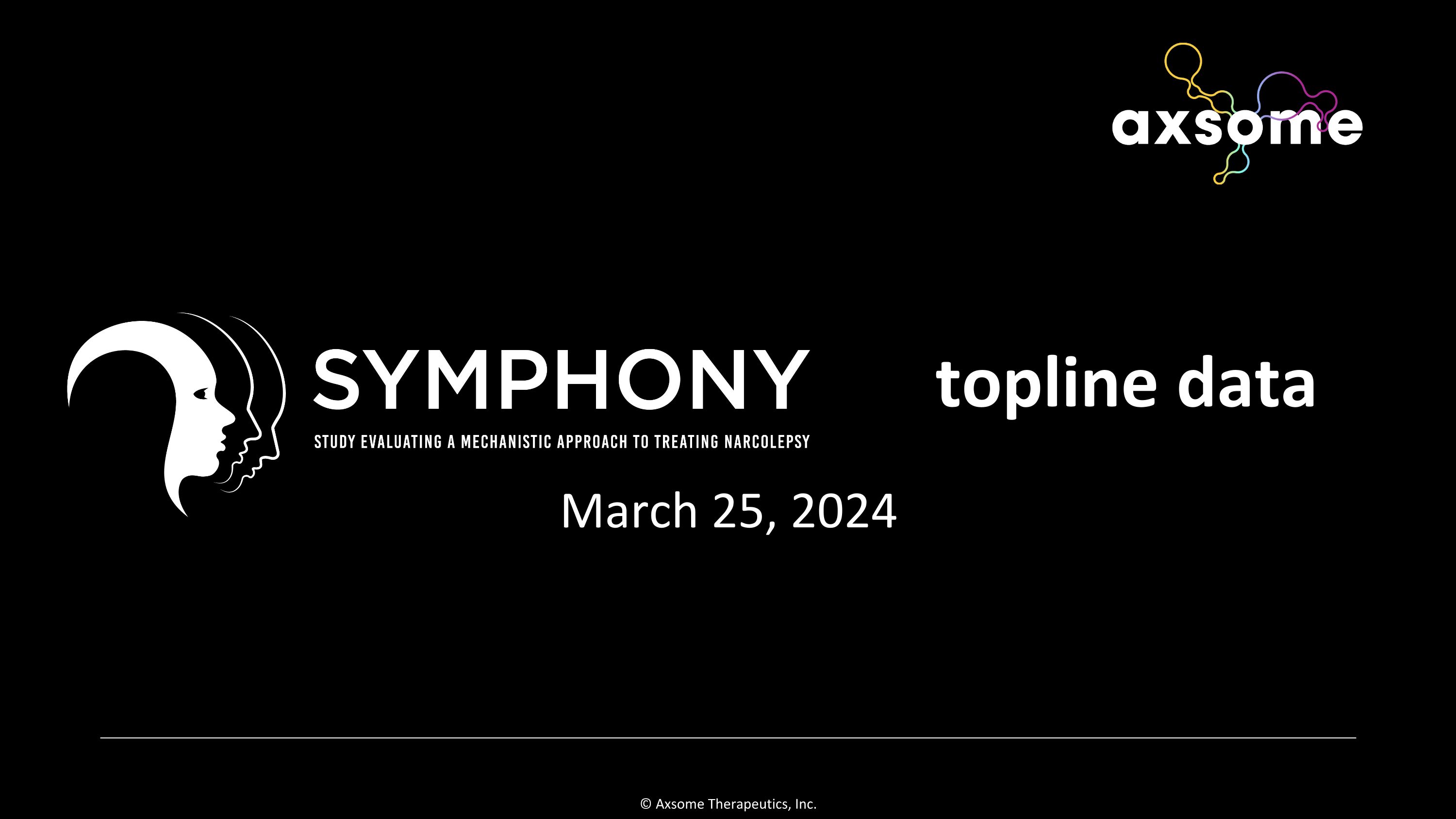
March 25, 2024 topline data
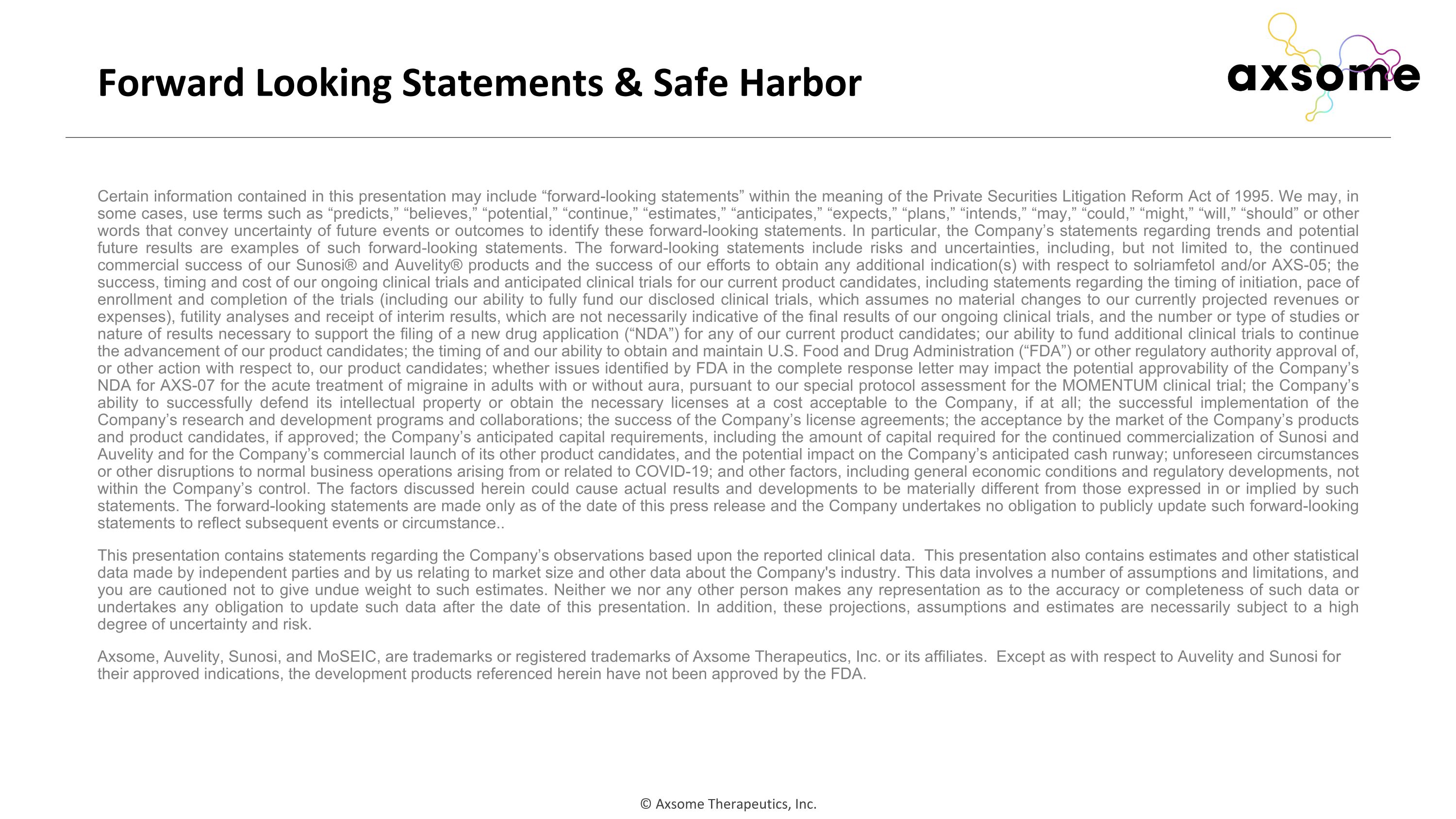
Forward Looking Statements & Safe Harbor Certain information contained in this presentation may include “forward-looking statements” within the meaning of the Private Securities Litigation Reform Act of 1995. We may, in some cases, use terms such as “predicts,” “believes,” “potential,” “continue,” “estimates,” “anticipates,” “expects,” “plans,” “intends,” “may,” “could,” “might,” “will,” “should” or other words that convey uncertainty of future events or outcomes to identify these forward-looking statements. In particular, the Company’s statements regarding trends and potential future results are examples of such forward-looking statements. The forward-looking statements include risks and uncertainties, including, but not limited to, the continued commercial success of our Sunosi® and Auvelity® products and the success of our efforts to obtain any additional indication(s) with respect to solriamfetol and/or AXS-05; the success, timing and cost of our ongoing clinical trials and anticipated clinical trials for our current product candidates, including statements regarding the timing of initiation, pace of enrollment and completion of the trials (including our ability to fully fund our disclosed clinical trials, which assumes no material changes to our currently projected revenues or expenses), futility analyses and receipt of interim results, which are not necessarily indicative of the final results of our ongoing clinical trials, and the number or type of studies or nature of results necessary to support the filing of a new drug application (“NDA”) for any of our current product candidates; our ability to fund additional clinical trials to continue the advancement of our product candidates; the timing of and our ability to obtain and maintain U.S. Food and Drug Administration (“FDA”) or other regulatory authority approval of, or other action with respect to, our product candidates; whether issues identified by FDA in the complete response letter may impact the potential approvability of the Company’s NDA for AXS-07 for the acute treatment of migraine in adults with or without aura, pursuant to our special protocol assessment for the MOMENTUM clinical trial; the Company’s ability to successfully defend its intellectual property or obtain the necessary licenses at a cost acceptable to the Company, if at all; the successful implementation of the Company’s research and development programs and collaborations; the success of the Company’s license agreements; the acceptance by the market of the Company’s products and product candidates, if approved; the Company’s anticipated capital requirements, including the amount of capital required for the continued commercialization of Sunosi and Auvelity and for the Company’s commercial launch of its other product candidates, and the potential impact on the Company’s anticipated cash runway; unforeseen circumstances or other disruptions to normal business operations arising from or related to COVID-19; and other factors, including general economic conditions and regulatory developments, not within the Company’s control. The factors discussed herein could cause actual results and developments to be materially different from those expressed in or implied by such statements. The forward-looking statements are made only as of the date of this press release and the Company undertakes no obligation to publicly update such forward-looking statements to reflect subsequent events or circumstance.. This presentation contains statements regarding the Company’s observations based upon the reported clinical data. This presentation also contains estimates and other statistical data made by independent parties and by us relating to market size and other data about the Company's industry. This data involves a number of assumptions and limitations, and you are cautioned not to give undue weight to such estimates. Neither we nor any other person makes any representation as to the accuracy or completeness of such data or undertakes any obligation to update such data after the date of this presentation. In addition, these projections, assumptions and estimates are necessarily subject to a high degree of uncertainty and risk. Axsome, Auvelity, Sunosi, and MoSEIC, are trademarks or registered trademarks of Axsome Therapeutics, Inc. or its affiliates. Except as with respect to Auvelity and Sunosi for their approved indications, the development products referenced herein have not been approved by the FDA.
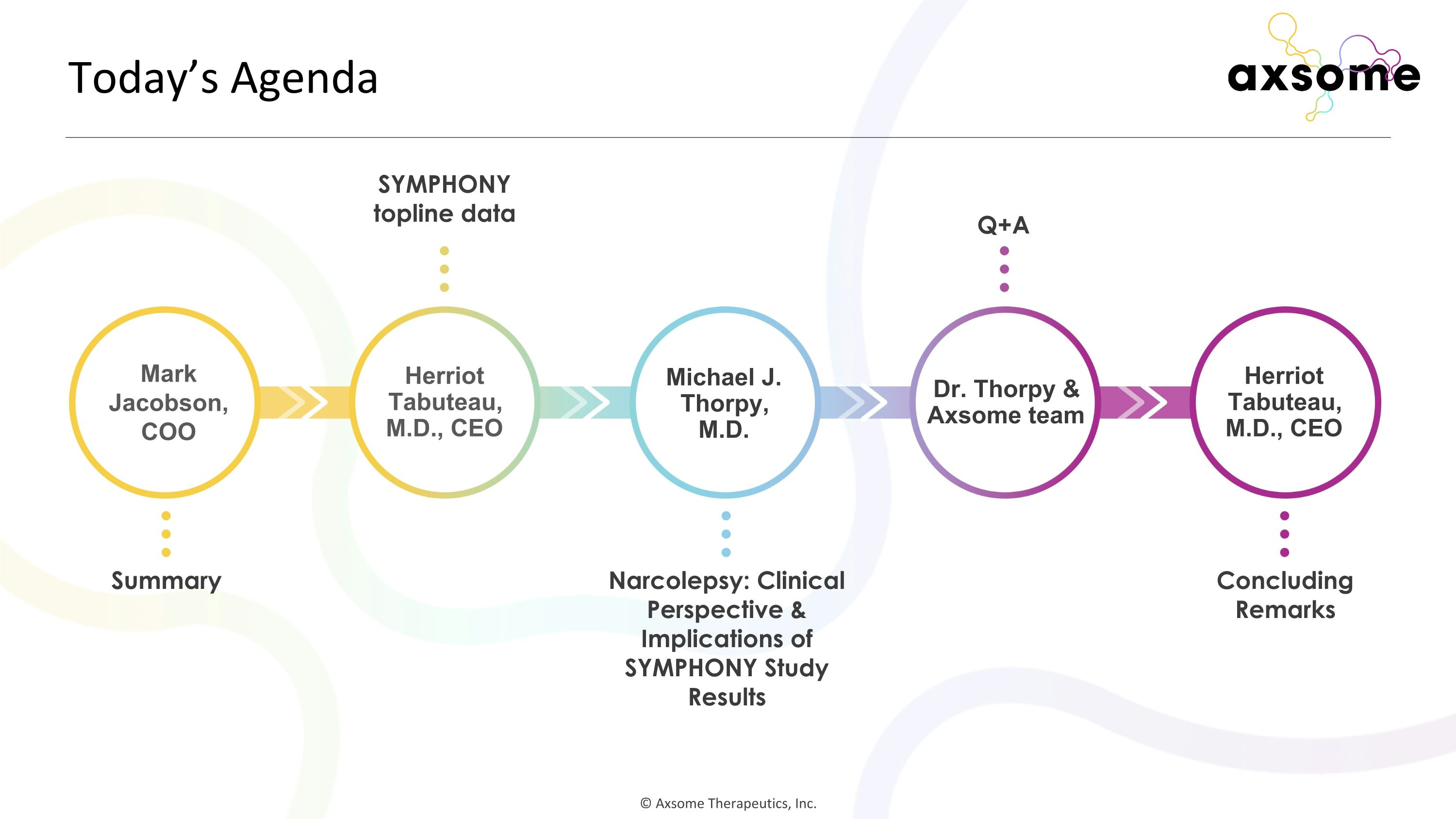
© Axsome Therapeutics, Inc. Mark Jacobson, COO Herriot Tabuteau, M.D., CEO Summary Narcolepsy: Clinical Perspective & Implications of SYMPHONY Study Results Concluding Remarks SYMPHONY topline data Q+A Michael J. Thorpy, M.D. Dr. Thorpy & Axsome team Herriot Tabuteau, M.D., CEO Today’s Agenda
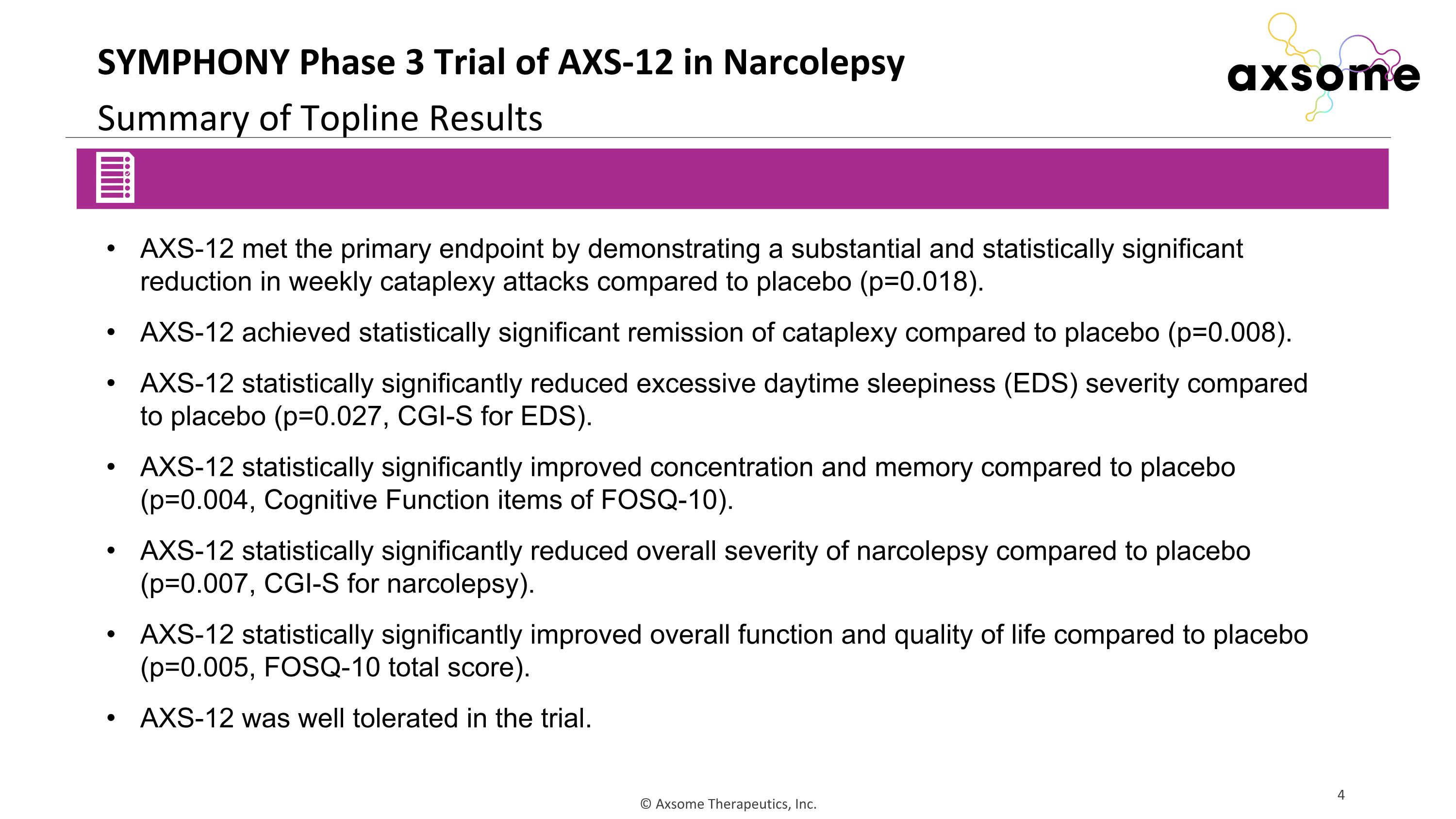
SYMPHONY Phase 3 Trial of AXS-12 in Narcolepsy�Summary of Topline Results AXS-12 met the primary endpoint by demonstrating a substantial and statistically significant reduction in weekly cataplexy attacks compared to placebo (p=0.018). AXS-12 achieved statistically significant remission of cataplexy compared to placebo (p=0.008). AXS-12 statistically significantly reduced excessive daytime sleepiness (EDS) severity compared to placebo (p=0.027, CGI-S for EDS). AXS-12 statistically significantly improved concentration and memory compared to placebo (p=0.004, Cognitive Function items of FOSQ-10). AXS-12 statistically significantly reduced overall severity of narcolepsy compared to placebo (p=0.007, CGI-S for narcolepsy). AXS-12 statistically significantly improved overall function and quality of life compared to placebo (p=0.005, FOSQ-10 total score). AXS-12 was well tolerated in the trial.
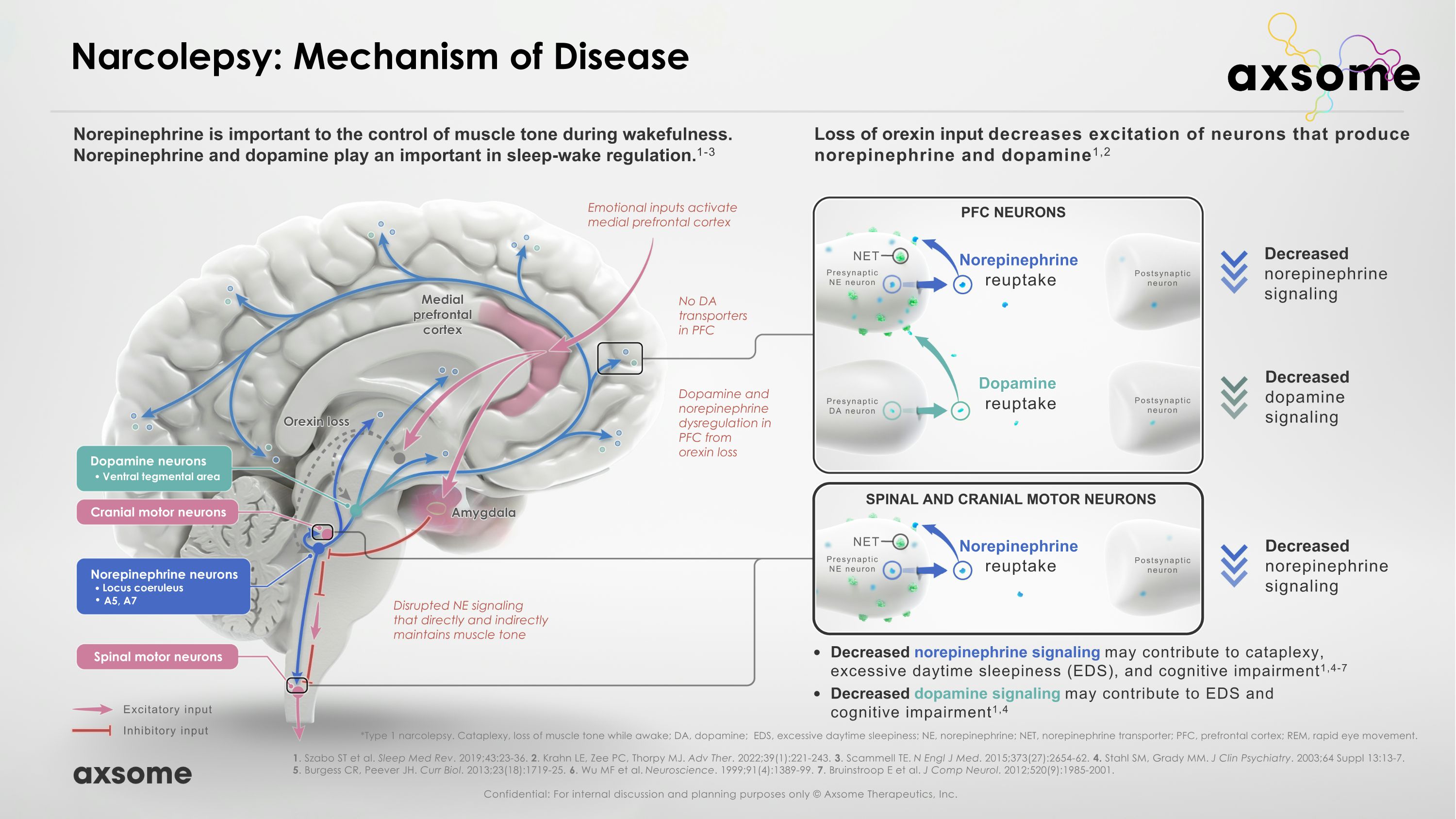
Narcolepsy: Mechanism of Disease Norepinephrine is important to the control of muscle tone during wakefulness. Norepinephrine and dopamine play an important in sleep-wake regulation.1-3 Loss of orexin input decreases excitation of neurons that produce norepinephrine and dopamine1,2 Decreased norepinephrine signaling Decreased dopamine signaling Decreased norepinephrine signaling may contribute to cataplexy, excessive daytime sleepiness (EDS), and cognitive impairment1,4-7 Decreased dopamine signaling may contribute to EDS and cognitive impairment1,4 Presynaptic DA neuron Dopamine and norepinephrine dysregulation in PFC from orexin loss Disrupted NE signaling that directly and indirectly maintains muscle tone Orexin loss Orexin loss Dopamine neurons Confidential: For internal discussion and planning purposes only © Axsome Therapeutics, Inc. *Type 1 narcolepsy. Cataplexy, loss of muscle tone while awake; DA, dopamine; EDS, excessive daytime sleepiness; NE, norepinephrine; NET, norepinephrine transporter; PFC, prefrontal cortex; REM, rapid eye movement. 1. Szabo ST et al. Sleep Med Rev. 2019;43:23-36. 2. Krahn LE, Zee PC, Thorpy MJ. Adv Ther. 2022;39(1):221-243. 3. Scammell TE. N Engl J Med. 2015;373(27):2654-62. 4. Stahl SM, Grady MM. J Clin Psychiatry. 2003;64 Suppl 13:13-7. 5. Burgess CR, Peever JH. Curr Biol. 2013;23(18):1719-25. 6. Wu MF et al. Neuroscience. 1999;91(4):1389-99. 7. Bruinstroop E et al. J Comp Neurol. 2012;520(9):1985-2001. Norepinephrine Norepinephrine Dopamine Dopamine Postsynaptic neuron Presynaptic NE neuron Postsynaptic neuron NET Emotional inputs activate medial prefrontal cortex Medial prefrontal cortex Medial prefrontal cortex Amygdala Amygdala No DA transporters in PFC Decreased norepinephrine signaling NET Presynaptic NE neuron Postsynaptic neuron Norepinephrine Norepinephrine reuptake reuptake reuptake PFC NEURONS PFC NEURONS SPINAL AND CRANIAL MOTOR NEURONS SPINAL AND CRANIAL MOTOR NEURONS Cranial motor neurons Norepinephrine neurons Spinal motor neurons Excitatory input Inhibitory input Ventral tegmental area Locus coeruleus A5, A7
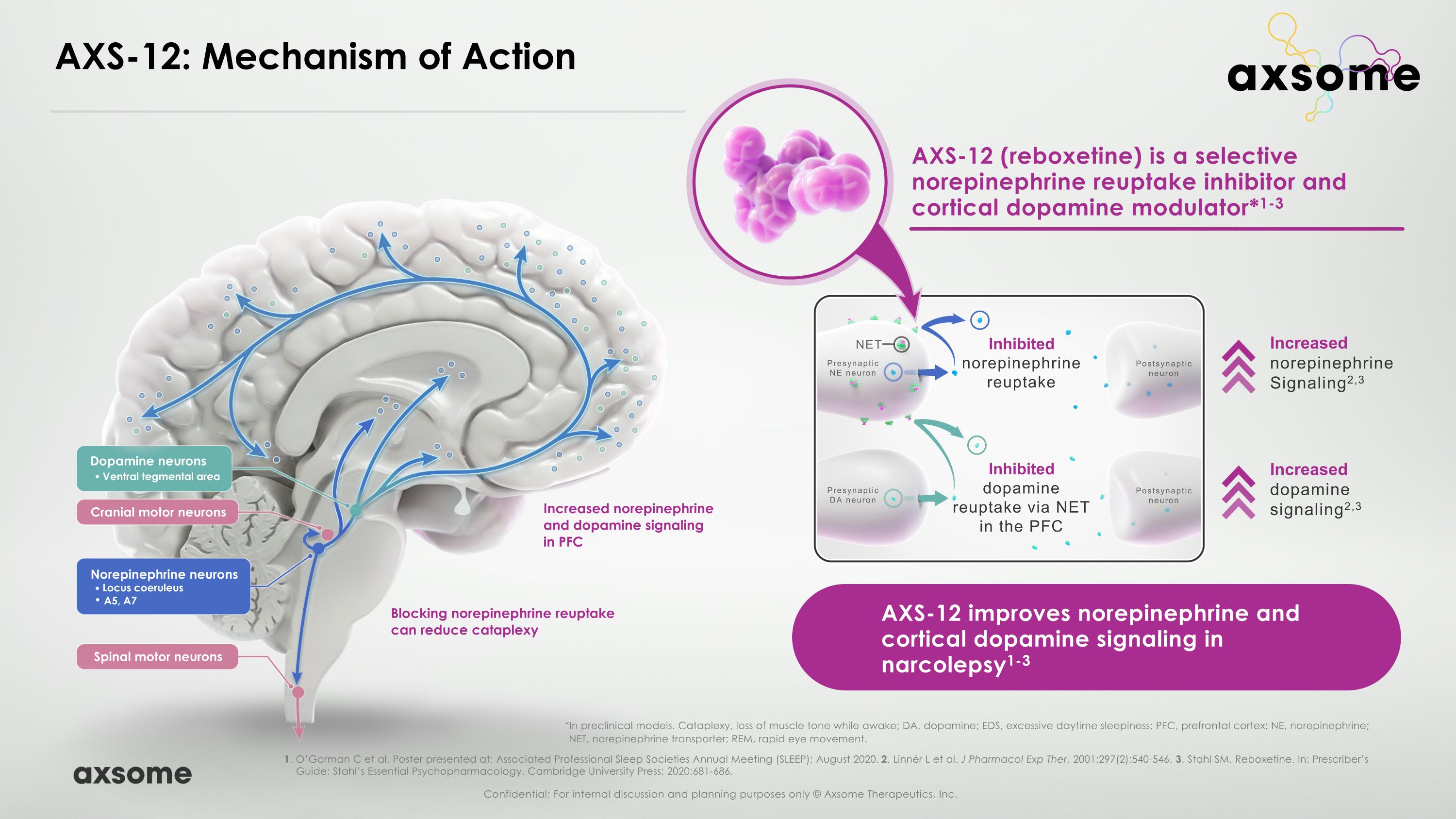
title and content slide Increased norepinephrine and dopamine signaling in PFC Blocking norepinephrine reuptake can reduce cataplexy AXS-12 (reboxetine) is a selective norepinephrine reuptake inhibitor and cortical dopamine modulator*1-3 Increased norepinephrine Signaling2,3 Increased dopamine signaling2,3 Inhibited norepinephrine reuptake Inhibited dopamine reuptake via NET in the PFC Confidential: For internal discussion and planning purposes only © Axsome Therapeutics, Inc. *In preclinical models. Cataplexy, loss of muscle tone while awake; DA, dopamine; EDS, excessive daytime sleepiness; PFC, prefrontal cortex; NE, norepinephrine; AXS-12 improves norepinephrine and cortical dopamine signaling in narcolepsy1-3 Presynaptic DA neuron Postsynaptic neuron Presynaptic NE neuron Postsynaptic neuron NET 1. O’Gorman C et al. Poster presented at: Associated Professional Sleep Societies Annual Meeting (SLEEP); August 2020. 2. Linnér L et al. J Pharmacol Exp Ther. 2001;297(2):540-546. 3. Stahl SM. Reboxetine. In: Prescriber’s Guide: Stahl’s Essential Psychopharmacology. Cambridge University Press; 2020:681-686. NET, norepinephrine transporter; REM, rapid eye movement. AXS-12: Mechanism of Action Dopamine neurons Cranial motor neurons Norepinephrine neurons Spinal motor neurons Ventral tegmental area Locus coeruleus A5, A7
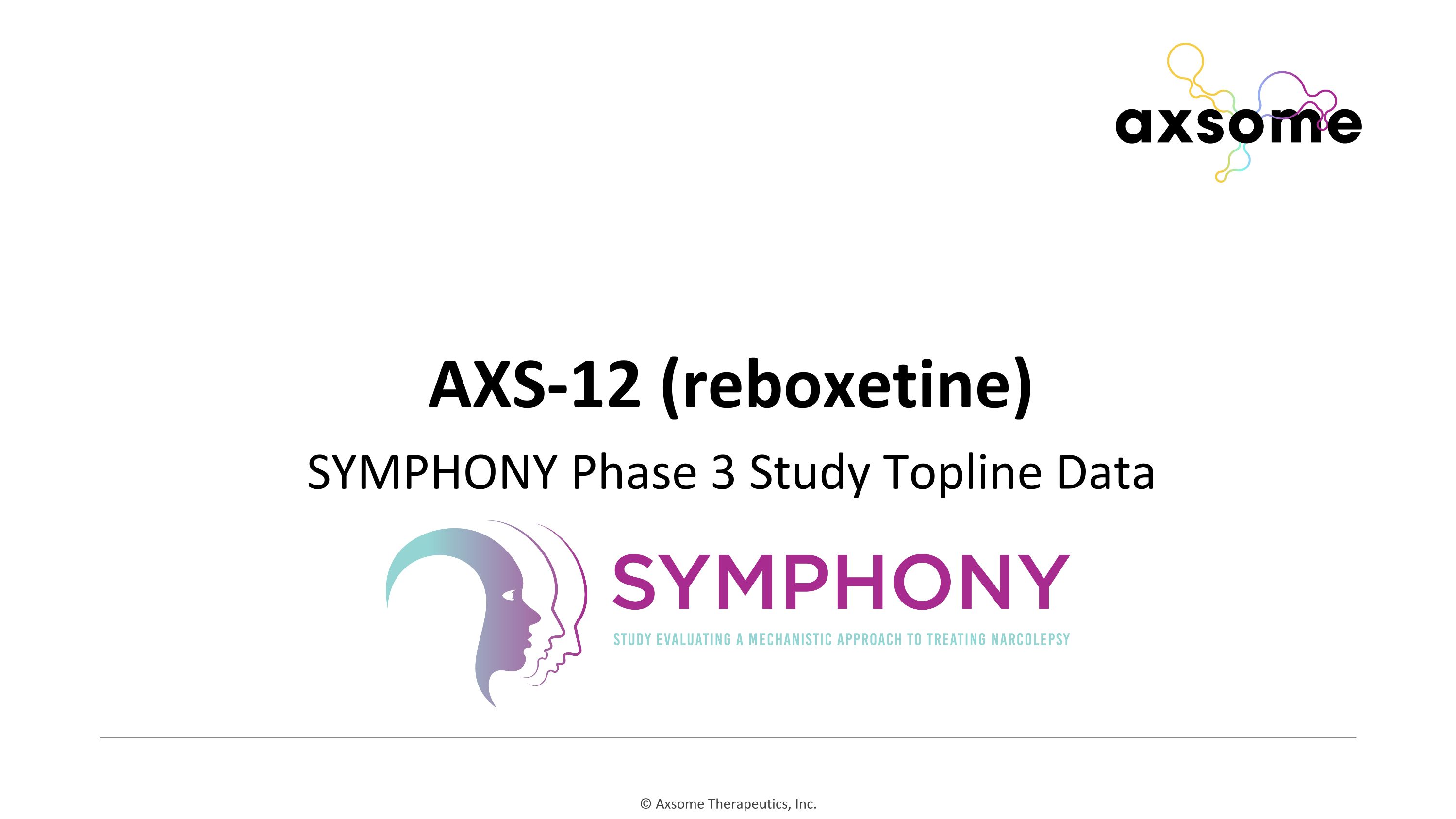
SYMPHONY Phase 3 Study Topline Data AXS-12 (reboxetine)
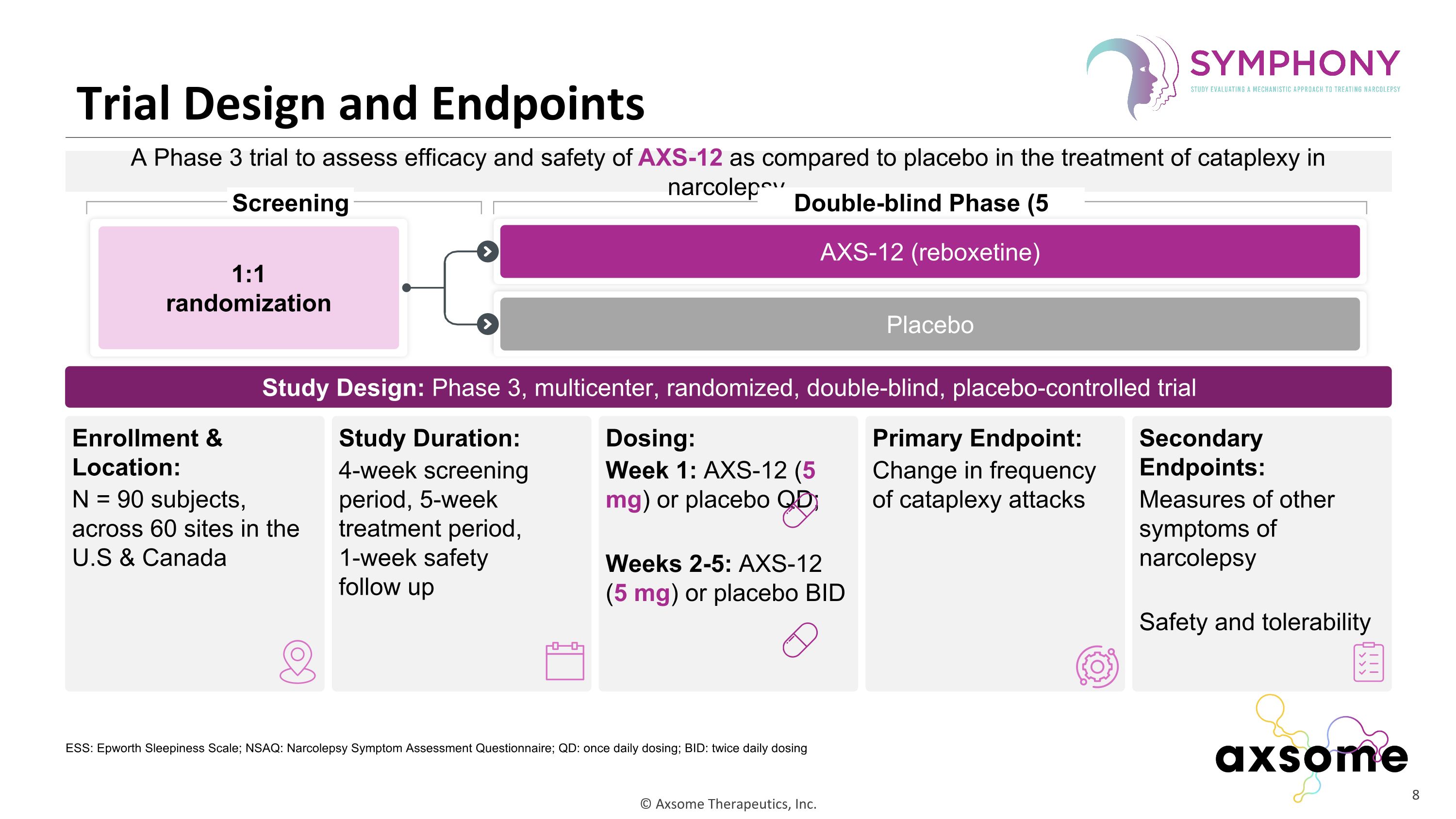
Trial Design and Endpoints A Phase 3 trial to assess efficacy and safety of AXS-12 as compared to placebo in the treatment of cataplexy in narcolepsy. ESS: Epworth Sleepiness Scale; NSAQ: Narcolepsy Symptom Assessment Questionnaire; QD: once daily dosing; BID: twice daily dosing Double-blind Phase (5 weeks) Screening AXS-12 (reboxetine) 1:1 randomization Placebo Study Design: Phase 3, multicenter, randomized, double-blind, placebo-controlled trial Dosing: Week 1: AXS-12 (5 mg) or placebo QD; Weeks 2-5: AXS-12�(5 mg) or placebo BID Primary Endpoint: Change in frequency of cataplexy attacks Secondary Endpoints: Measures of other symptoms of narcolepsy Safety and tolerability Enrollment & Location: N = 90 subjects, �across 60 sites in the U.S & Canada Study Duration: 4-week screening period, 5-week treatment period, �1-week safety follow up
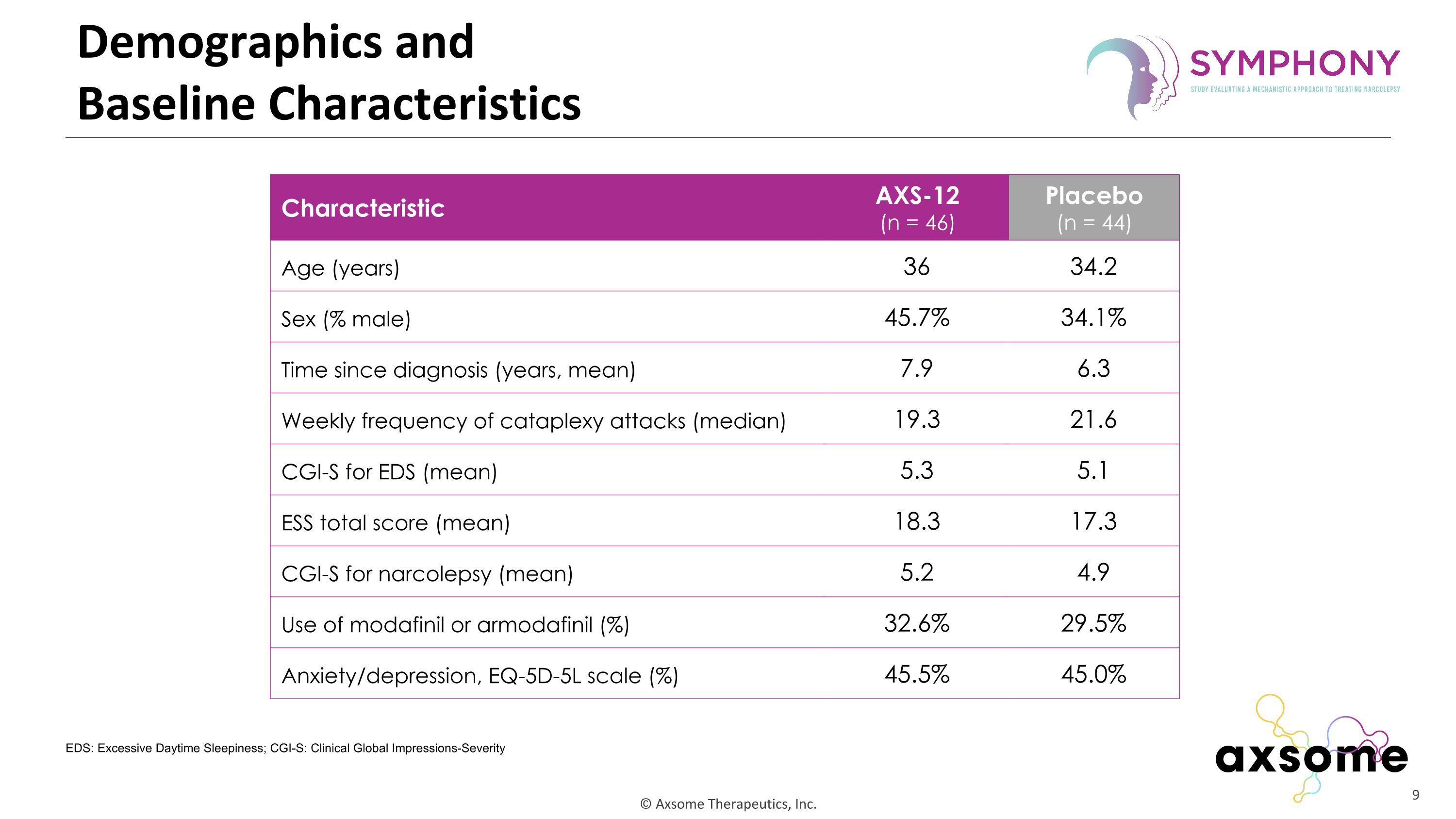
Demographics and �Baseline Characteristics EDS: Excessive Daytime Sleepiness; CGI-S: Clinical Global Impressions-Severity Characteristic AXS-12 (n = 46) Placebo (n = 44) Age (years) 36 34.2 Sex (% male) 45.7% 34.1% Time since diagnosis (years, mean) 7.9 6.3 Weekly frequency of cataplexy attacks (median) 19.3 21.6 CGI-S for EDS (mean) 5.3 5.1 ESS total score (mean) 18.3 17.3 CGI-S for narcolepsy (mean) 5.2 4.9 Use of modafinil or armodafinil (%) 32.6% 29.5% Anxiety/depression, EQ-5D-5L scale (%) 45.5% 45.0%
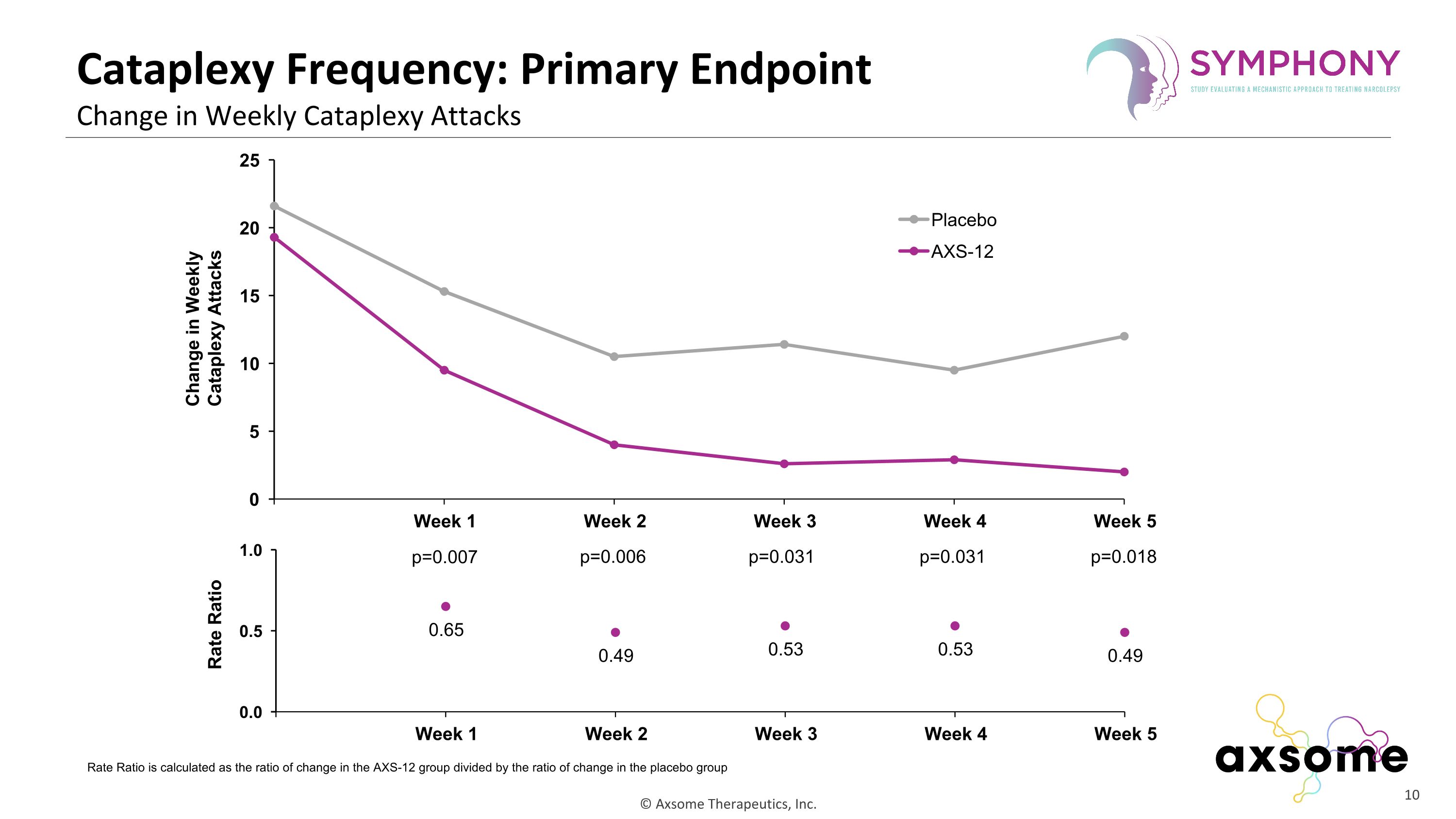
Cataplexy Frequency: Primary Endpoint�Change in Weekly Cataplexy Attacks Change in Weekly �Cataplexy Attacks Rate Ratio p=0.007 p=0.006 p=0.031 p=0.031 p=0.018 Rate Ratio is calculated as the ratio of change in the AXS-12 group divided by the ratio of change in the placebo group

Achievement of Cataplexy Remission�Patients Achieving Remission (100% Reduction) in Cataplexy Attacks p=0.008 p=0.013 p=0.008
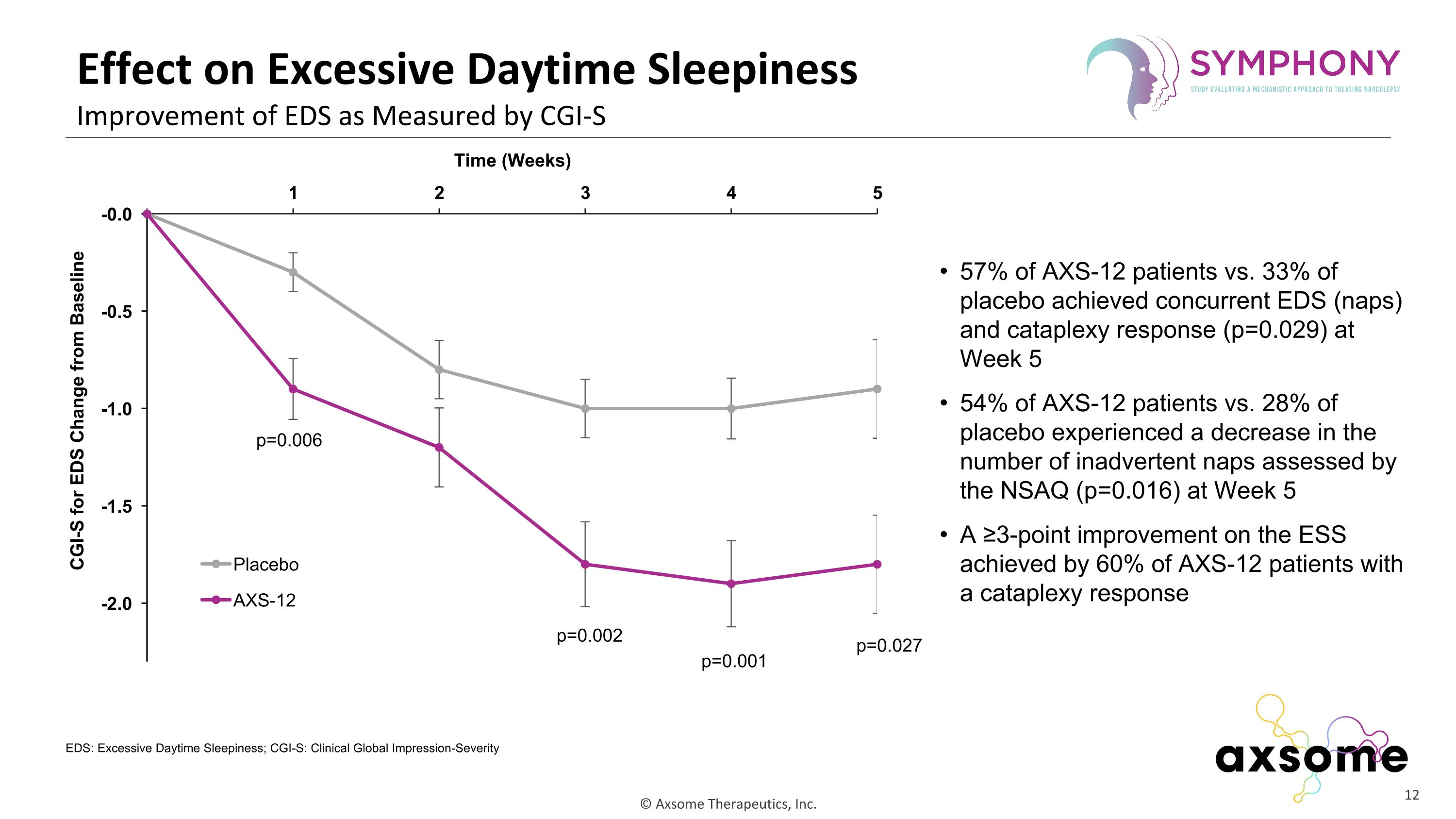
Effect on Excessive Daytime Sleepiness�Improvement of EDS as Measured by CGI-S EDS: Excessive Daytime Sleepiness; CGI-S: Clinical Global Impression-Severity p=0.006 p=0.002 p=0.001 p=0.027 57% of AXS-12 patients vs. 33% of placebo achieved concurrent EDS (naps) and cataplexy response (p=0.029) at Week 5 54% of AXS-12 patients vs. 28% of placebo experienced a decrease in the number of inadvertent naps assessed by the NSAQ (p=0.016) at Week 5 A ≥3-point improvement on the ESS achieved by 60% of AXS-12 patients with a cataplexy response
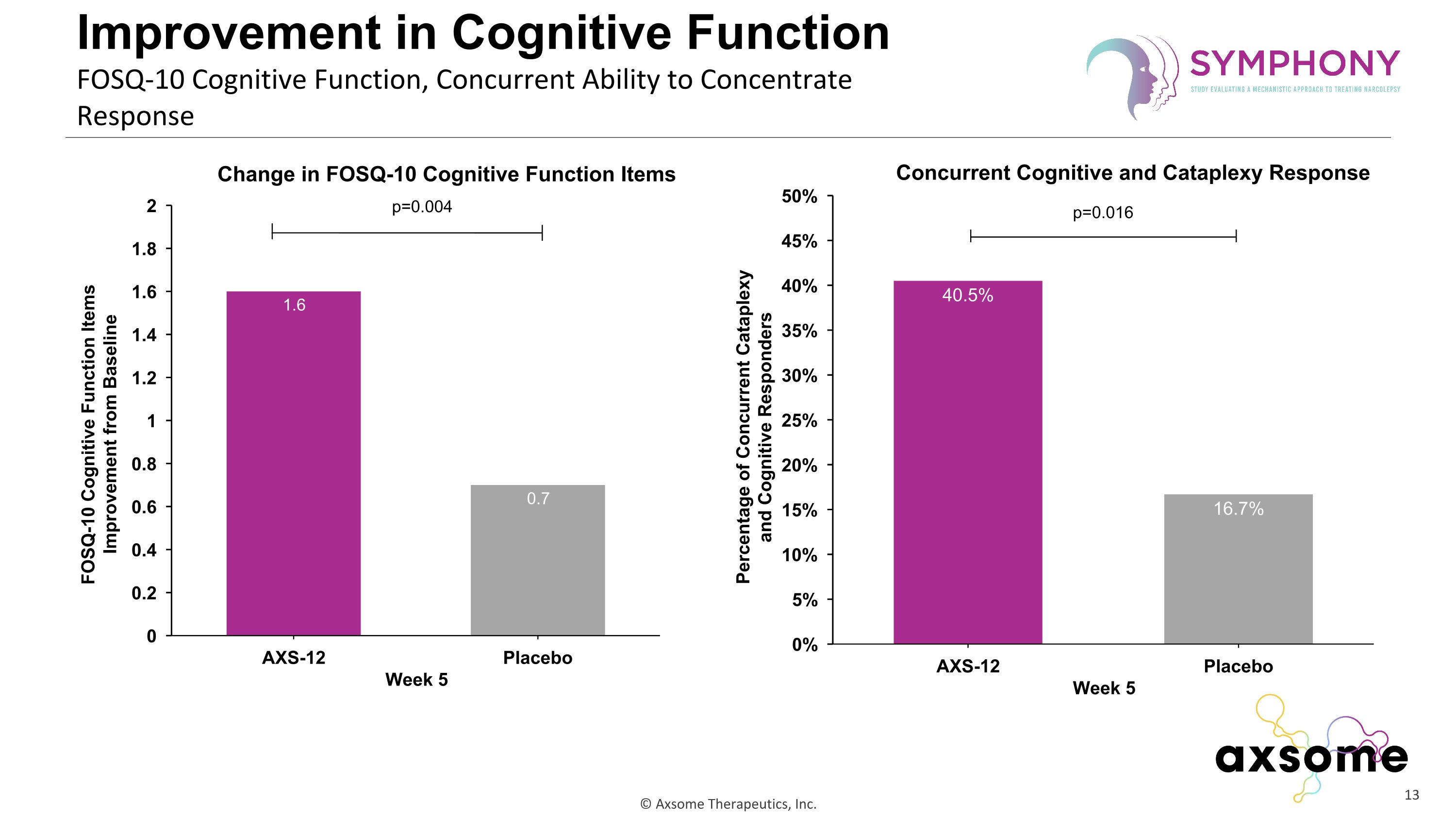
Improvement in Cognitive Function�FOSQ-10 Cognitive Function, Concurrent Ability to Concentrate �Response p=0.016 p=0.004
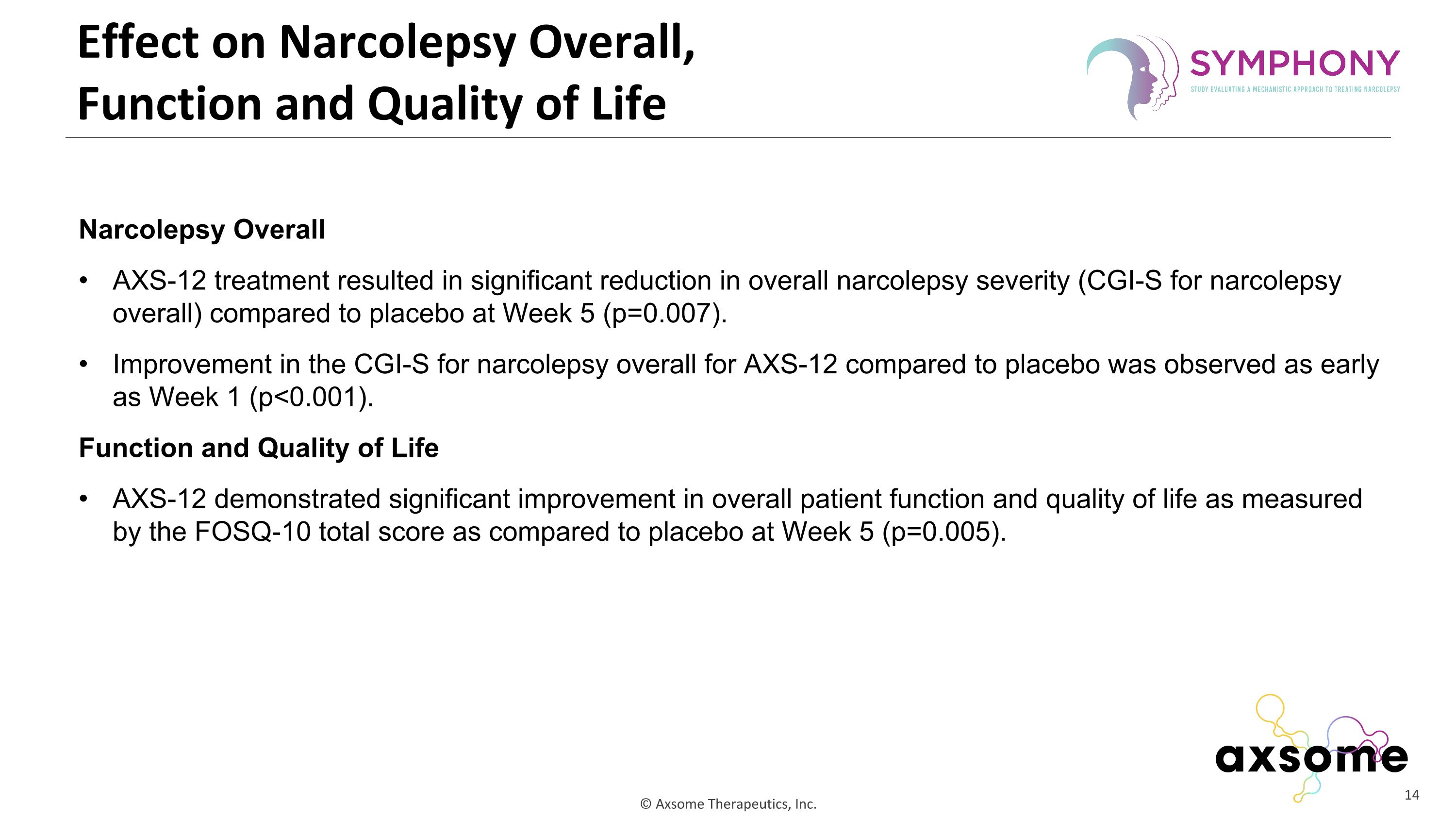
Effect on Narcolepsy Overall, �Function and Quality of Life Narcolepsy Overall AXS-12 treatment resulted in significant reduction in overall narcolepsy severity (CGI-S for narcolepsy overall) compared to placebo at Week 5 (p=0.007). Improvement in the CGI-S for narcolepsy overall for AXS-12 compared to placebo was observed as early as Week 1 (p<0.001). Function and Quality of Life AXS-12 demonstrated significant improvement in overall patient function and quality of life as measured by the FOSQ-10 total score as compared to placebo at Week 5 (p=0.005).
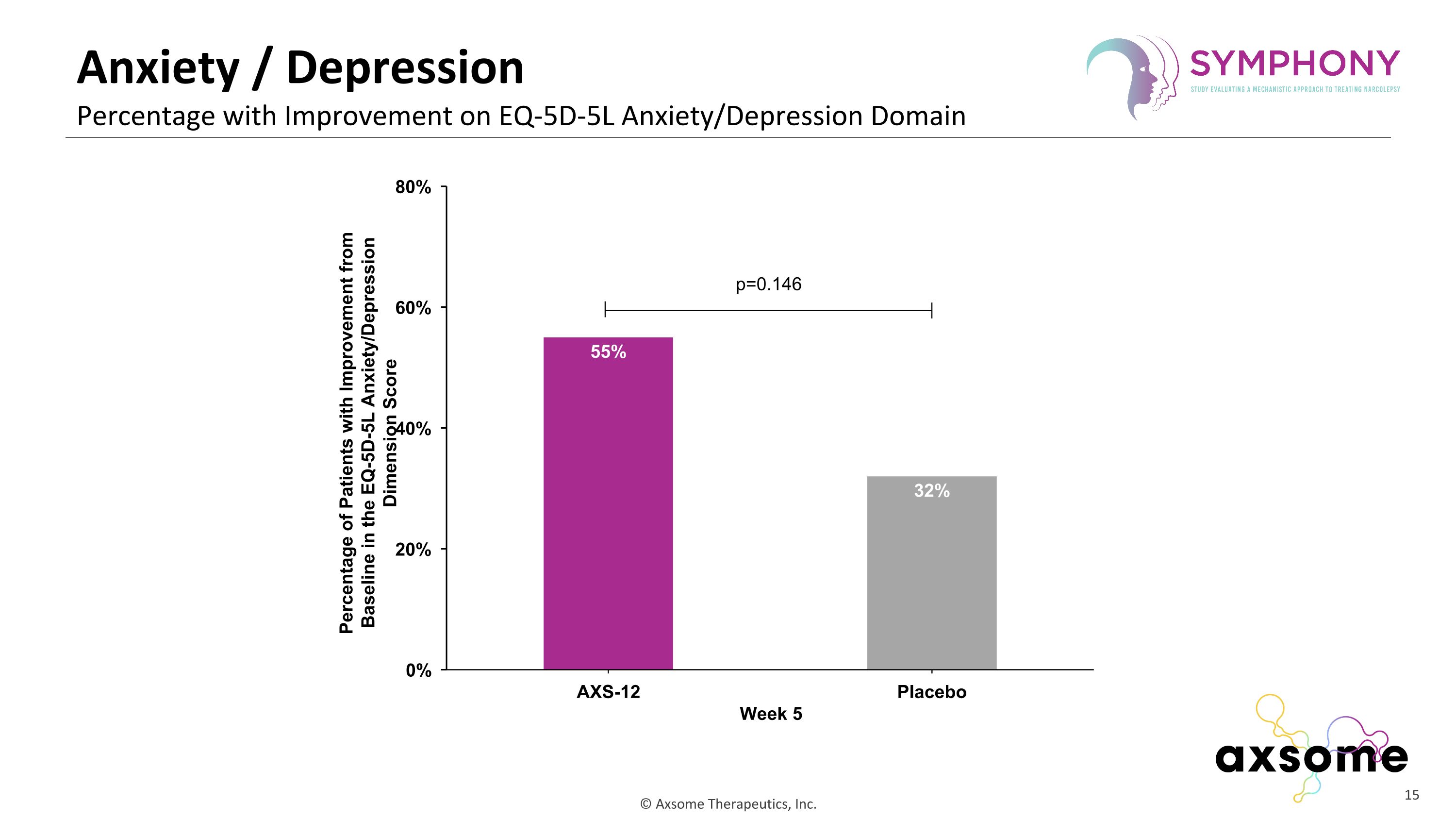
Anxiety / Depression�Percentage with Improvement on EQ-5D-5L Anxiety/Depression Domain p=0.146
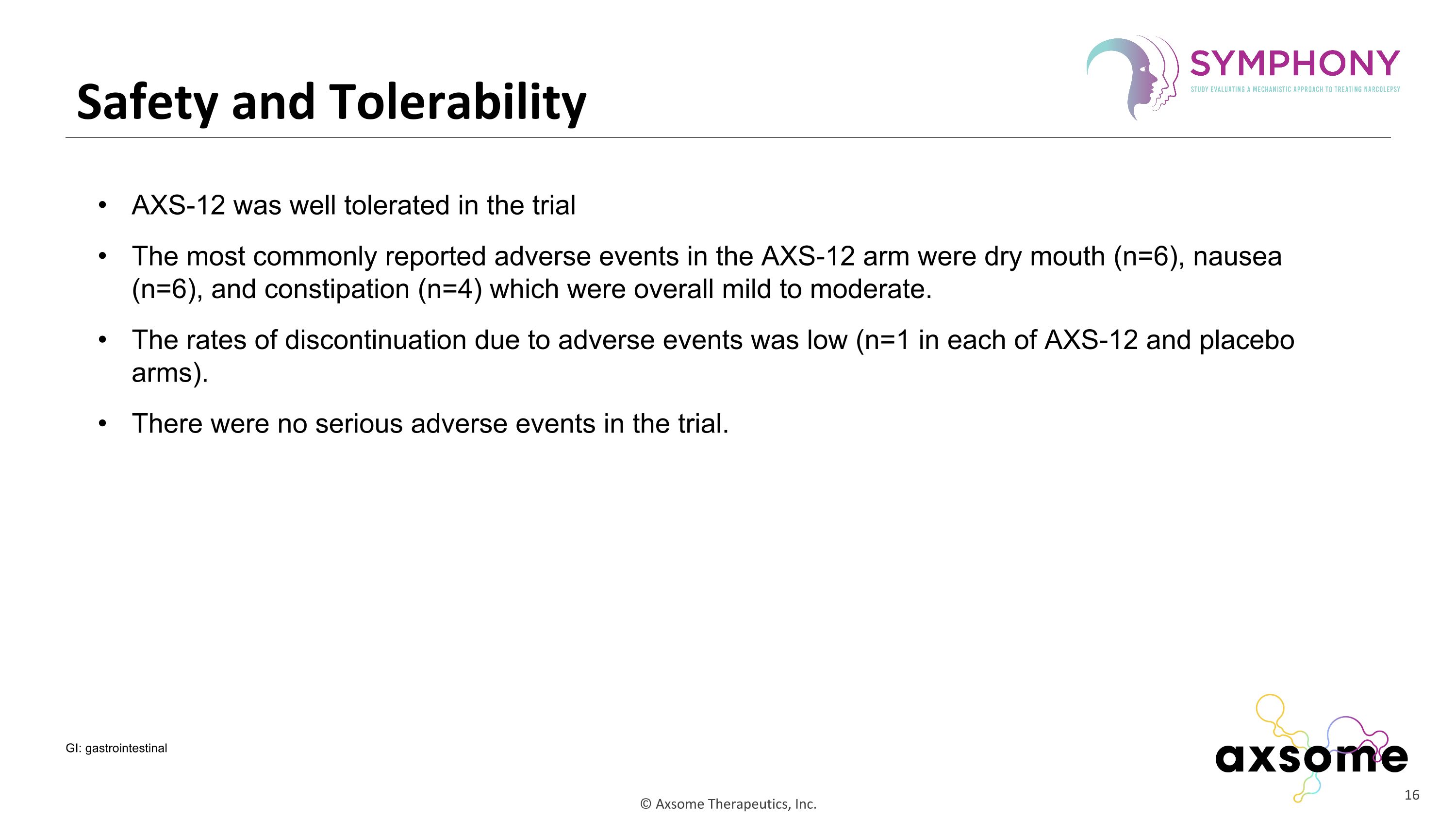
Safety and Tolerability GI: gastrointestinal AXS-12 was well tolerated in the trial The most commonly reported adverse events in the AXS-12 arm were dry mouth (n=6), nausea (n=6), and constipation (n=4) which were overall mild to moderate. The rates of discontinuation due to adverse events was low (n=1 in each of AXS-12 and placebo arms). There were no serious adverse events in the trial.
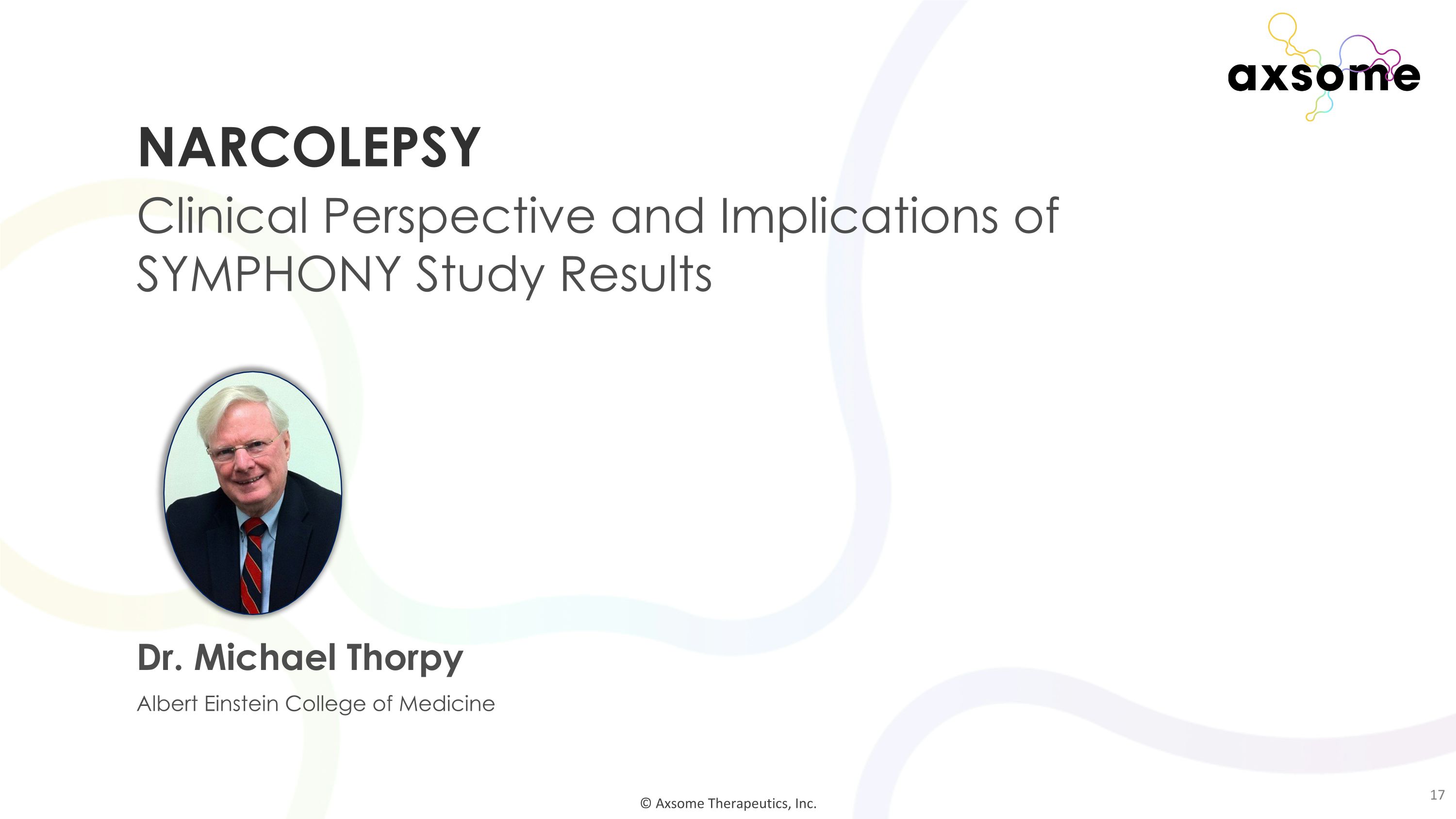
Dr. Michael Thorpy Albert Einstein College of Medicine NARCOLEPSY Clinical Perspective and Implications of SYMPHONY Study Results © Axsome Therapeutics, Inc.
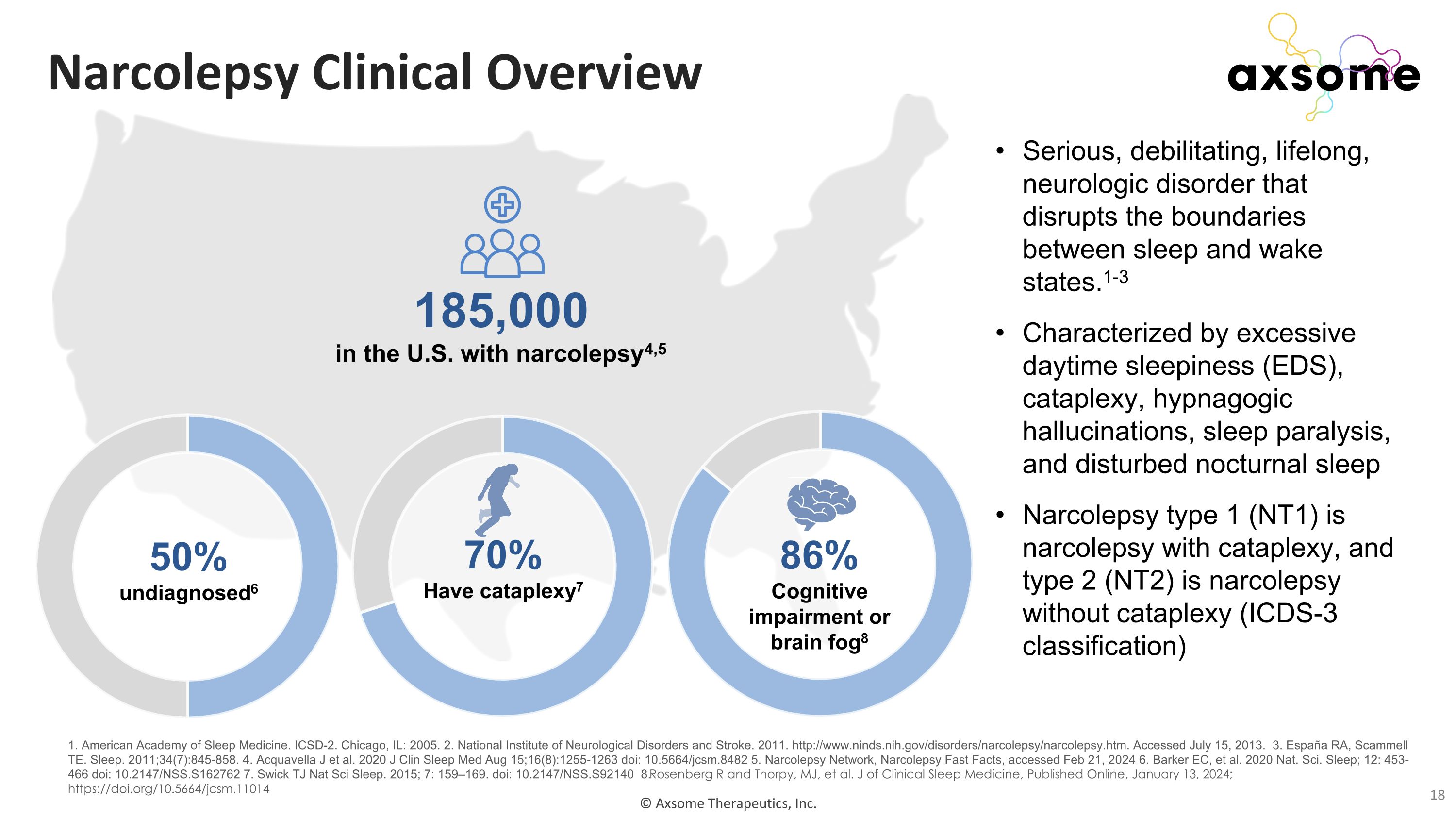
© Axsome Therapeutics, Inc. Narcolepsy Clinical Overview 185,000 in the U.S. with narcolepsy4,5 Serious, debilitating, lifelong, neurologic disorder that disrupts the boundaries between sleep and wake states.1-3 Characterized by excessive daytime sleepiness (EDS), cataplexy, hypnagogic hallucinations, sleep paralysis, and disturbed nocturnal sleep Narcolepsy type 1 (NT1) is narcolepsy with cataplexy, and type 2 (NT2) is narcolepsy without cataplexy (ICDS-3 classification) 1. American Academy of Sleep Medicine. ICSD-2. Chicago, IL: 2005. 2. National Institute of Neurological Disorders and Stroke. 2011. http://www.ninds.nih.gov/disorders/narcolepsy/narcolepsy.htm. Accessed July 15, 2013. 3. España RA, Scammell TE. Sleep. 2011;34(7):845-858. 4. Acquavella J et al. 2020 J Clin Sleep Med Aug 15;16(8):1255-1263 doi: 10.5664/jcsm.8482 5. Narcolepsy Network, Narcolepsy Fast Facts, accessed Feb 21, 2024 6. Barker EC, et al. 2020 Nat. Sci. Sleep; 12: 453-466 doi: 10.2147/NSS.S162762 7. Swick TJ Nat Sci Sleep. 2015; 7: 159–169. doi: 10.2147/NSS.S92140 8. Rosenberg R and Thorpy, MJ, et al. J of Clinical Sleep Medicine, Published Online, January 13, 2024; https://doi.org/10.5664/jcsm.11014 86% Cognitive impairment or brain fog8 70% Have cataplexy7 50% undiagnosed6
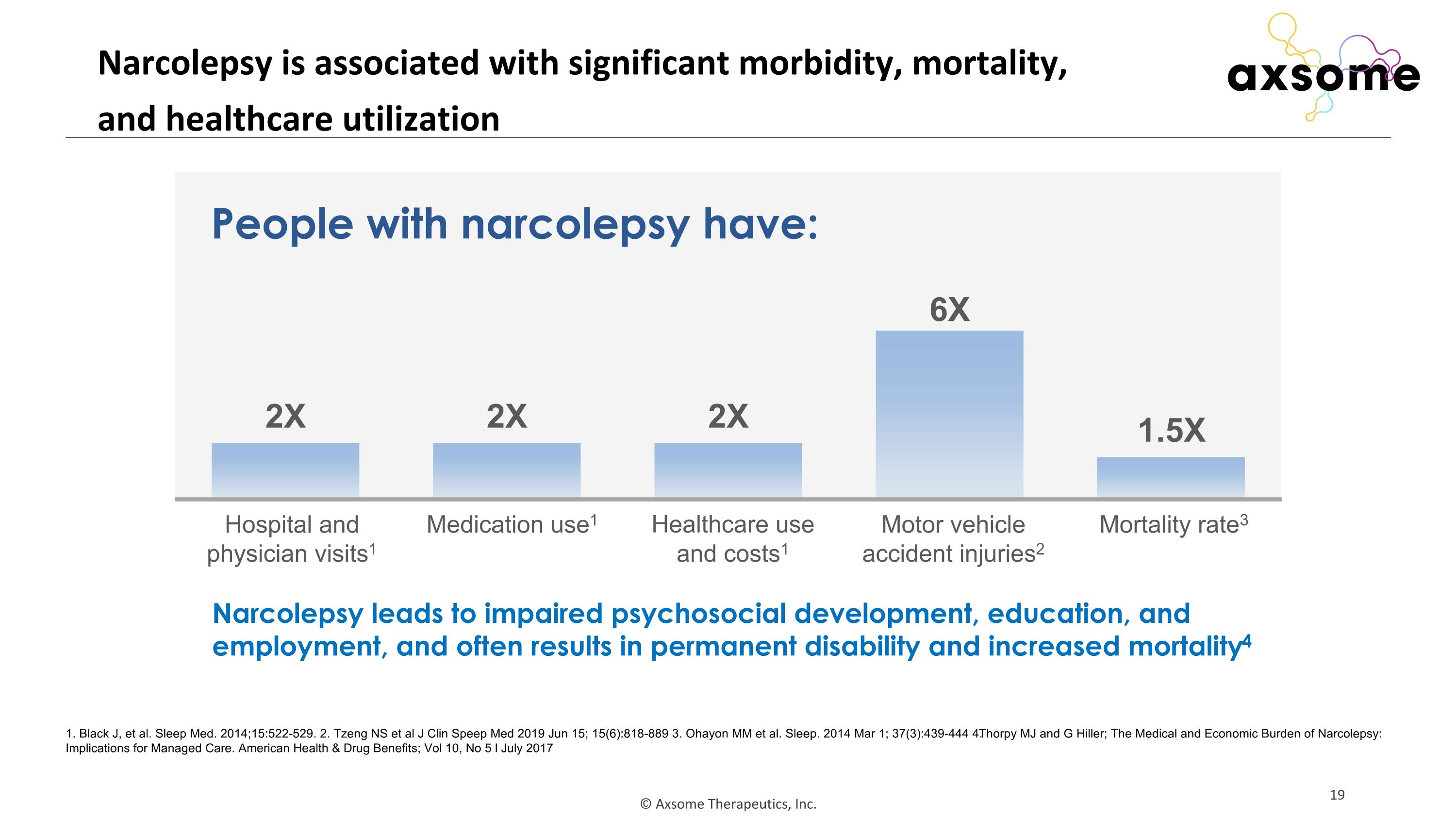
Narcolepsy is associated with significant morbidity, mortality, and healthcare utilization Mortality rate3 Motor vehicle accident injuries2 Hospital and physician visits1 Medication use1 Healthcare use �and costs1 People with narcolepsy have: Narcolepsy leads to impaired psychosocial development, education, and employment, and often results in permanent disability and increased mortality4 1. Black J, et al. Sleep Med. 2014;15:522-529. 2. Tzeng NS et al J Clin Speep Med 2019 Jun 15; 15(6):818-889 3. Ohayon MM et al. Sleep. 2014 Mar 1; 37(3):439-444 4. Thorpy MJ and G Hiller; The Medical and Economic Burden of Narcolepsy: Implications for Managed Care. American Health & Drug Benefits; Vol 10, No 5 l July 2017
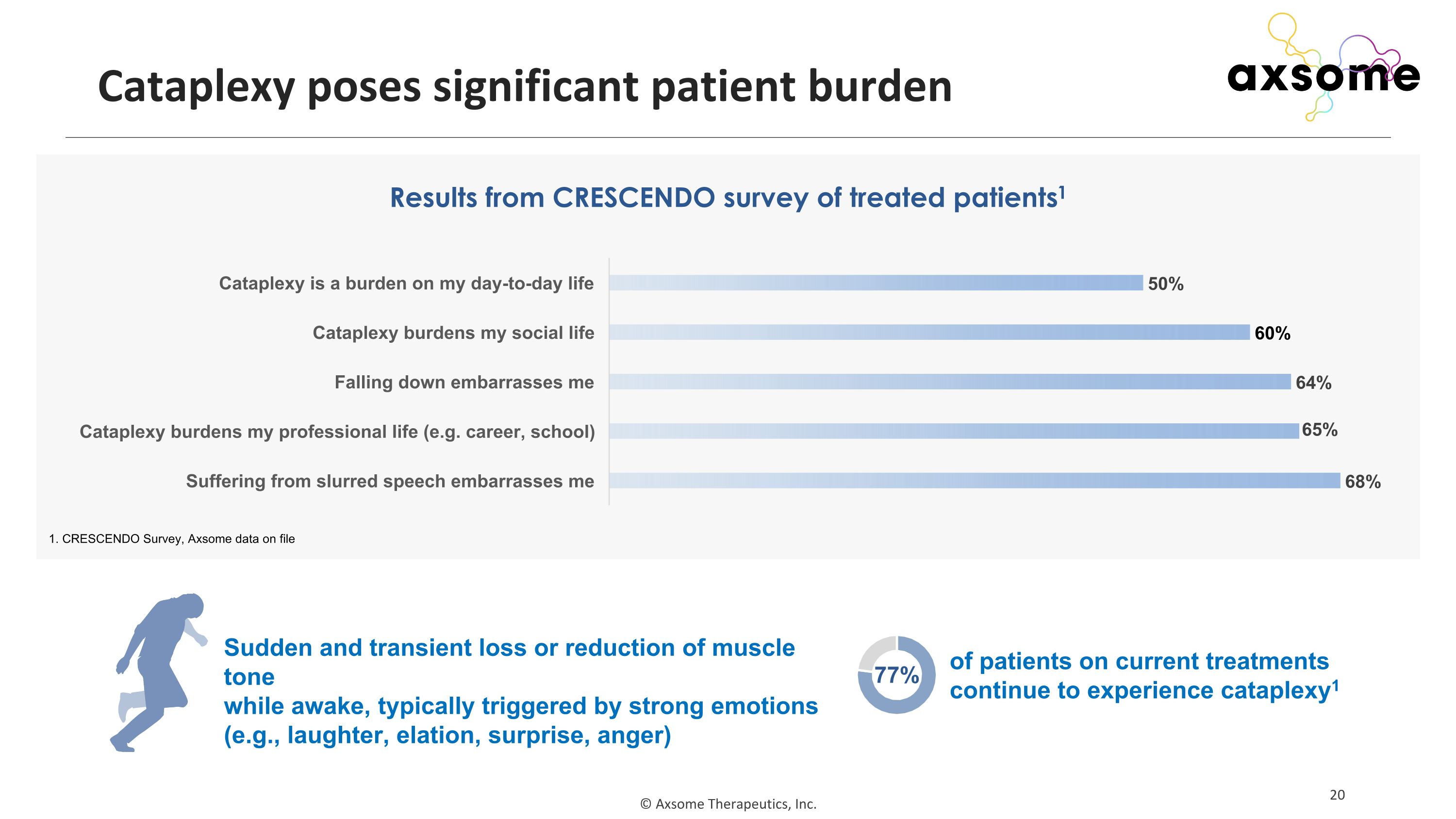
Cataplexy poses significant patient burden Results from CRESCENDO survey of treated patients1 1. CRESCENDO Survey, Axsome data on file Sudden and transient loss or reduction of muscle tone while awake, typically triggered by strong emotions (e.g., laughter, elation, surprise, anger) 77% of patients on current treatments continue to experience cataplexy1
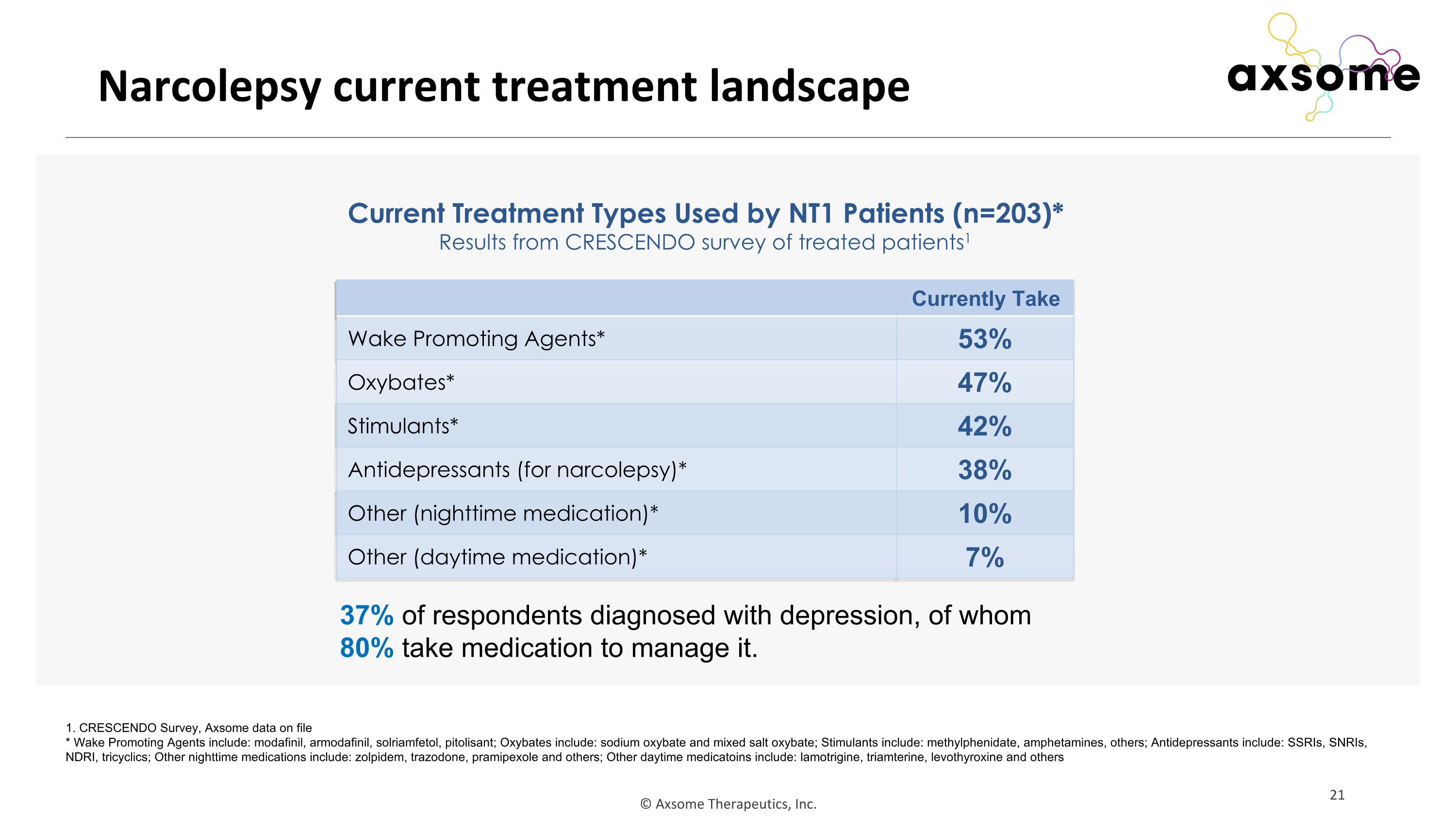
Narcolepsy current treatment landscape Current Treatment Types Used by NT1 Patients (n=203)* Results from CRESCENDO survey of treated patients1 Currently Take Wake Promoting Agents* 53% Oxybates* 47% Stimulants* 42% Antidepressants (for narcolepsy)* 38% Other (nighttime medication)* 10% Other (daytime medication)* 7% 1. CRESCENDO Survey, Axsome data on file * Wake Promoting Agents include: modafinil, armodafinil, solriamfetol, pitolisant; Oxybates include: sodium oxybate and mixed salt oxybate; Stimulants include: methylphenidate, amphetamines, others; Antidepressants include: SSRIs, SNRIs, NDRI, tricyclics; Other nighttime medications include: zolpidem, trazodone, pramipexole and others; Other daytime medicatoins include: lamotrigine, triamterine, levothyroxine and others 37% of respondents diagnosed with depression, of whom 80% take medication to manage it.
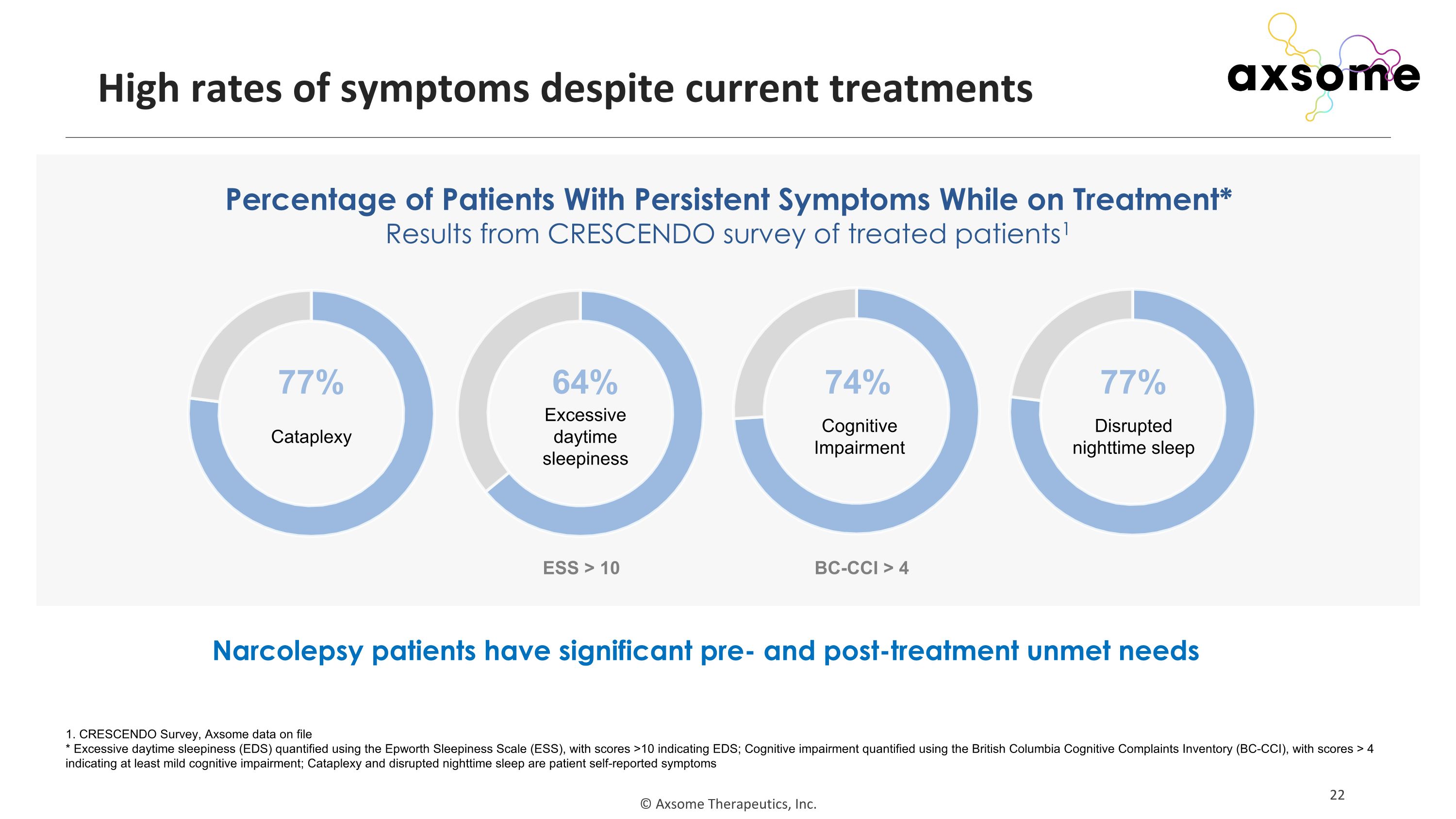
High rates of symptoms despite current treatments Percentage of Patients With Persistent Symptoms While on Treatment* Results from CRESCENDO survey of treated patients1 Narcolepsy patients have significant pre- and post-treatment unmet needs 1. CRESCENDO Survey, Axsome data on file * Excessive daytime sleepiness (EDS) quantified using the Epworth Sleepiness Scale (ESS), with scores >10 indicating EDS; Cognitive impairment quantified using the British Columbia Cognitive Complaints Inventory (BC-CCI), with scores > 4 indicating at least mild cognitive impairment; Cataplexy and disrupted nighttime sleep are patient self-reported symptoms 77% Cataplexy 74% Cognitive Impairment 77% Disrupted nighttime sleep 64% Excessive daytime sleepiness ESS > 10 BC-CCI > 4
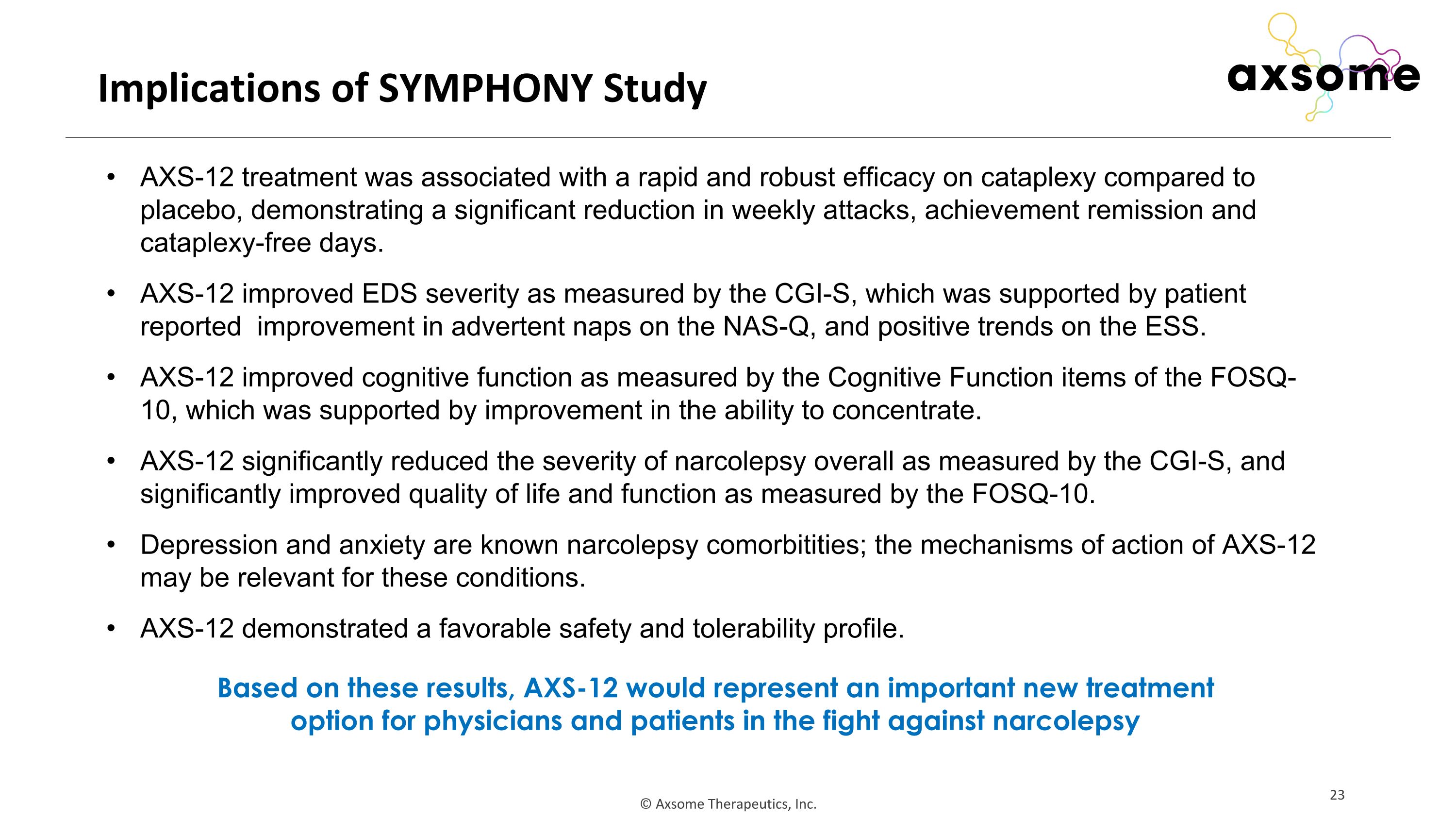
Implications of SYMPHONY Study AXS-12 treatment was associated with a rapid and robust efficacy on cataplexy compared to placebo, demonstrating a significant reduction in weekly attacks, achievement remission and cataplexy-free days. AXS-12 improved EDS severity as measured by the CGI-S, which was supported by patient reported improvement in advertent naps on the NAS-Q, and positive trends on the ESS. AXS-12 improved cognitive function as measured by the Cognitive Function items of the FOSQ-10, which was supported by improvement in the ability to concentrate. AXS-12 significantly reduced the severity of narcolepsy overall as measured by the CGI-S, and significantly improved quality of life and function as measured by the FOSQ-10. Depression and anxiety are known narcolepsy comorbitities; the mechanisms of action of AXS-12 may be relevant for these conditions. AXS-12 demonstrated a favorable safety and tolerability profile. Based on these results, AXS-12 would represent an important new treatment option for physicians and patients in the fight against narcolepsy
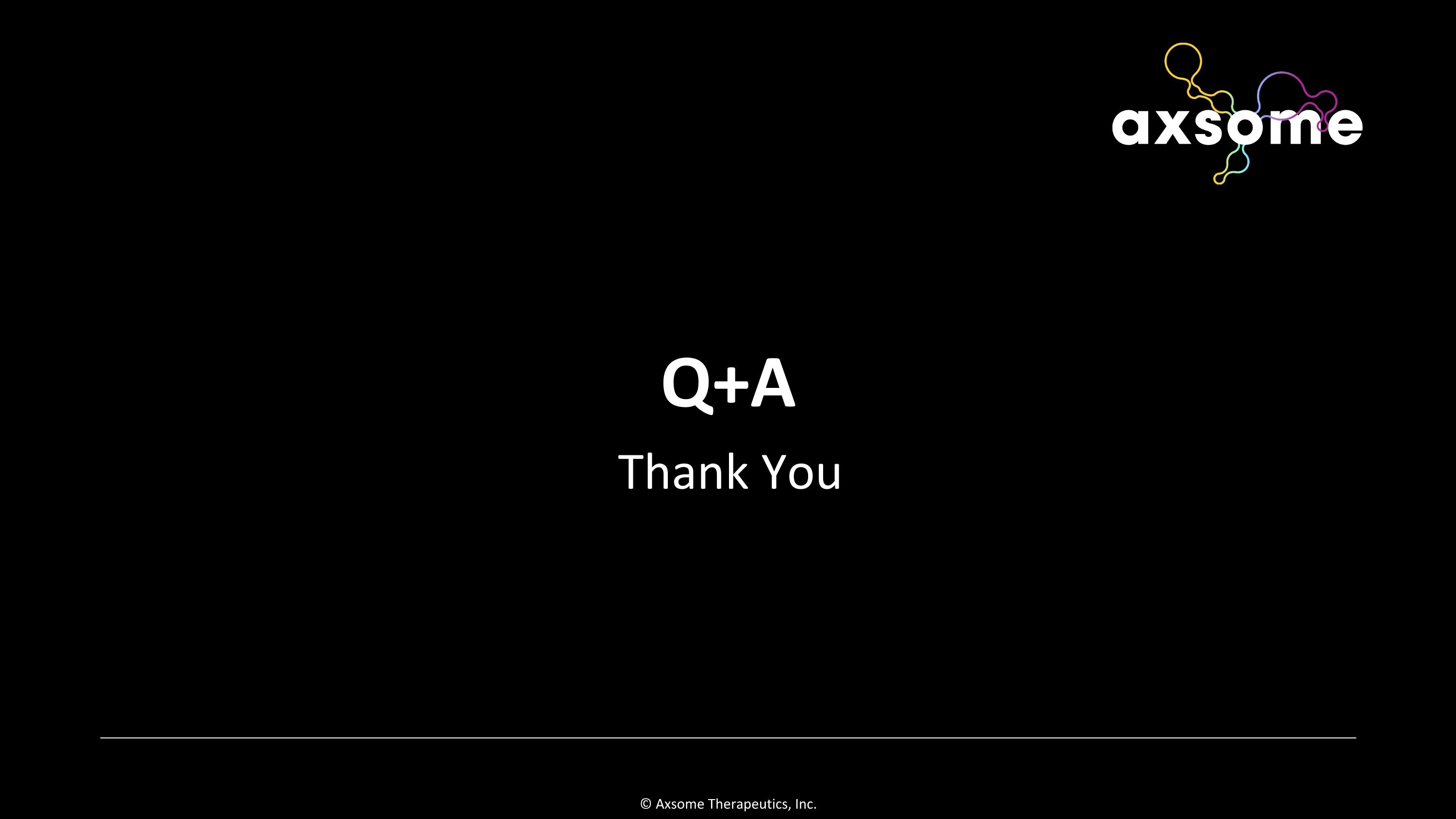
Thank You Q+A
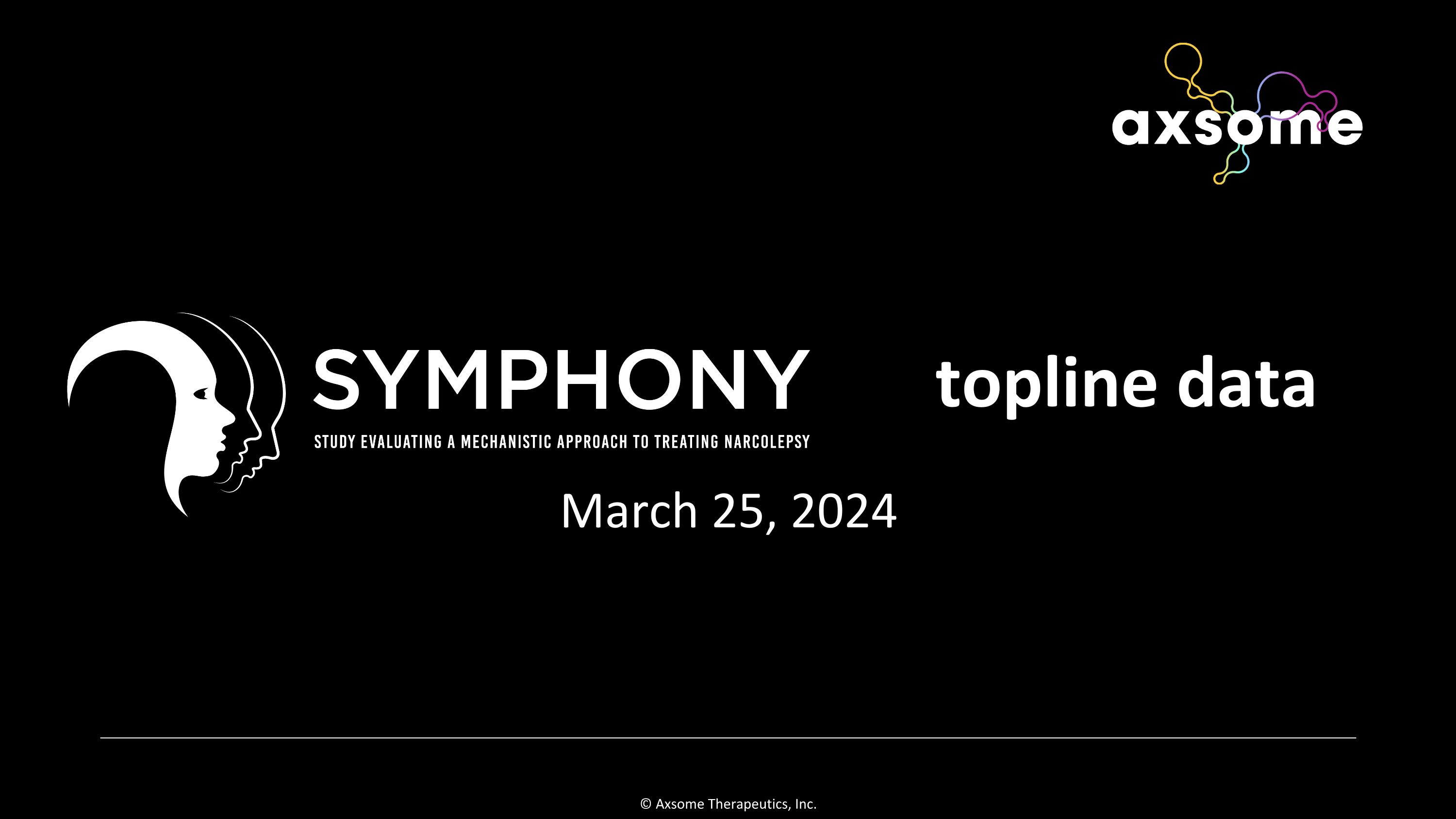
March 25, 2024 topline data
























